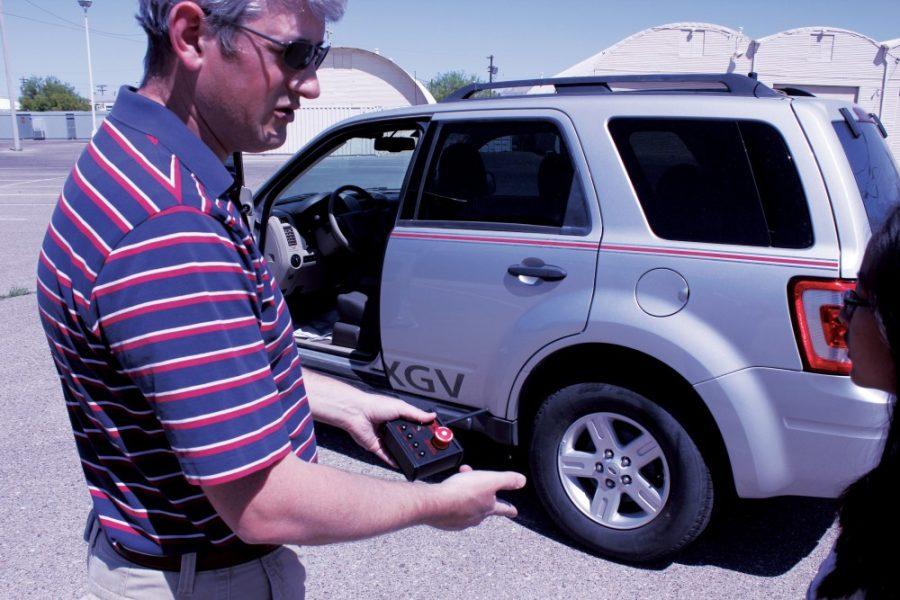When Jonathan Sprinkle was young, he invented his own crossword puzzles and convinced his dad to make copies of them at work.
For Sprinkle, now an assistant professor in the UA Electrical and Computer Engineering Department, inventing those crossword puzzles led him to realize that he had the ingenuity he needed to pursue his current career.
Now, one of the main projects Sprinkle is working on is an autonomous car that can drive itself.
“The root of the inspiration for any problem that I work on as an engineer is to have societal impact,” Sprinkle said. “I want to do something not just because it’s cool, but because it could have a multiplier effect in society.”
Sprinkle is working with graduate students to enable the car to perform tasks by itself.
Among the students on the team is Sean Whitsitt, an electrical and computer engineering graduate student who works to ensure that the car rejects unsafe commands.
Whitsitt said that safety is one of the biggest priorities in the research he has worked on. The ultimate goal is to ensure the car would be safe even if a child were in control of it.
Though the team has yet to let the car drive on the streets by itself, they have tested it out in empty parking lots.
“Sitting in the car when it starts driving itself, you see the wheel take over and start spinning on its own,” Whitsitt said. “It’s kind of eerie.”
Sprinkle recently won a National Science Foundation Career Award. The award recognizes strength in research and teaching and will award Sprinkle a grant of $460,000 over the next five years to support his research.
However, Jeff Goldberg, dean of the College of Engineering, said the grant money isn’t the most important thing when it comes to Sprinkle’s work.
“When I think about engineering, engineers help people,” Goldberg said. “That’s the most important thing for me. It’s not just the amount of money you get, it’s the kind of work you’re doing and how it impacts the rest of society.”
Goldberg said that Sprinkle’s research on autonomous cars could have a huge impact on the future.
“Thirty years from now you and I won’t be driving,” Goldberg said. “The work that he does allows people to think about, ‘How do you make cars drive themselves?’”
It could allow for safer cars, fewer deaths and accidents on the road and more efficient transportation, Goldberg said.
“Plus, driving is a huge waste of time,” Goldberg added. “Driving to Phoenix is a perfect example — it’s two hours of time wasted. Wouldn’t it be better if I didn’t need to control that car? I could do other things.”
According to Tamal Bose, head of the UA Electrical and Computer Engineering Department, Sprinkle also brings a passion for teaching and outreach to his classes that makes him popular among students.
“His love for his work makes him a successful teacher,” Bose said. “He really loves what he’s doing and it rubs off on other people, it shows.”
Sprinkle said he plans to involve high school students in his work with the autonomous car.
Students would create computer code to control the car’s performance in experiments, giving them
a chance to apply what they’re learning in math classes and to see a physical manifestation of that
knowledge, Sprinkle said.
“They’ll get to drive the autonomous car in 10th or 11th grade,” Sprinkle said. “That’s really cool. No matter how exciting you think your geometry teacher was, it’s not this exciting.”
Sprinkle said he hopes to inspire students to pursue engineering the same way he was inspired at a young age.
“By going to a high school, we find people that might not otherwise have considered a career in engineering,” Sprinkle said. “But now engineering comes to them and they can make a one-hour investment to explore it.”
Ultimately, Sprinkle said he hopes some of the technology they’re working on with the autonomous car will be further developed by car manufacturers, who can apply it on a larger scale.
Sprinkle’s ability to understand and adapt to changing technology means he can have an impact on the future, Goldberg said.
“He’s a rising superstar and works on some of the more exciting projects we have,” Goldberg said. “You’ve got to have some people out there in the front edge and thinking about where we should be going. I wish I had a hundred faculty members like him.”








